Physical Address
304 North Cardinal St.
Dorchester Center, MA 02124
Key aspects of vascular Doppler imaging include knowledge of anatomy and waveform morphology, scanning technique, and attention to detail.
Spectral Doppler velocity criteria can characterize stenosis detected by gray-scale and color Doppler.
Doppler evaluation of peripheral artery disease can provide diagnostic information and enable surgical planning and evaluation of bypass grafts.
Extremity aneurysm and pseudoaneurysm have typical Doppler findings similar to other areas of the arterial system.
Evaluation of the upper and lower extremity venous system is primarily performed with sonography.
Differentiation of acute from residual or chronic deep venous thrombosis (DVT) with imaging and clinical parameters is often difficult.
Controversial venous issues include clinical criteria for treatment of DVT, when to recommend a follow-up examination, calf vein evaluation, and two-point or focused examination approach.
Preoperative sonographic mapping of upper extremity and thigh vessels assists surgical planning for placement of hemodialysis arteriovenous fistula (AVF) and grafts.
Postoperative evaluation of hemodialysis AVF and grafts with ultrasound aids the assessment of AVF maturation, as well as evaluation for access stenosis, steal, thrombus, and focal complications.
Prior chapters have described details of physics of Doppler analysis and use of ultrasound in the assessment of the vasculature supplying the head and neck. In this chapter we describe assessment of the peripheral arteries and veins, as well as arteriovenous fistula (AVF) and grafts. In general, these areas are readily evaluated by Doppler ultrasound. Because they are usually located at depths of 6 cm or less, the extremity vessels are more consistently imaged than those in the abdomen or thorax. Availability of sufficient imaging windows allows the transducer to be placed over the vascular area of interest with overlying tissue containing bone or gas. Transducers with frequencies greater than 5 MHz can typically be used.
Gray-scale sonography is useful for evaluating the presence of atherosclerotic plaque or confirming extravascular masses. Color flow Doppler imaging allows for a rapid survey of the area of interest, and then spectral Doppler can be used to characterize blood flow patterns.
Standardized protocols, such as those provided by the American College of Radiology (ACR), American Institute of Ultrasound in Medicine, and Society of Radiologists in Ultrasound should be followed. It is recommended that examinations be performed in an accredited laboratory with participation in one of the vascular accreditation programs, such as the ACR or the Intersocietal Commission for the Accreditation of Vascular Laboratories, in order to achieve a national standard of excellence and to improve the chance of success of peripheral arterial and venous ultrasound examinations. In the setting of a dedicated staff and with physician support, ultrasound can be used to diagnose many peripheral vascular abnormalities definitively and avoid the need for ionizing radiation or intravenous contrasted cross-sectional studies.
A variety of symptoms and signs can be evaluated by arterial ultrasound. Sonographic examination is relatively rapid and has benefits over other modalities, such as real-time technique, lack of ionizing radiation, and relatively low expense. In the last two decades, the number of indications for peripheral artery ultrasound has expanded. The most recent ACR practice parameter on the topic lists indications for the examination, which include claudication and/or rest pain in the lower extremities to evaluate for arterial stenosis or occlusion. Patients with pain, discoloration, or ulcer formation in the extremities (most commonly lower) may have tissue ischemia or necrosis from arterial stenosis or occlusion. Additional symptoms of numbness or cold extremity may be noted. However, symptomatology may vary depending on the rapidity of onset and whether collaterals have developed to decrease the effects of stenosis on the tissues. In some patients, vascular abnormalities may be subclinical and found incidentally on imaging for other indications. Once an abnormality has been identified, ultrasound can monitor progression of disease, determine success or failure after intervention, and identify acceptable vessels for bypass graft creation.
Other extremity abnormalities can be evaluated sonographically. Focal masses can be assessed to exclude vascular causes such as aneurysm or fistula with venous enlargement. When chronic positional upper extremity symptoms are present, ultrasound can evaluate for thoracic outlet syndrome. More peripherally, Doppler can document patency of the palmar arch in surgical planning for bypass graft harvesting, and it can assess the radial artery before and after vascular access.
In the acute setting, traumatic injuries can be evaluated to determine adjacent arterial patency. Pseudoaneurysms and dissections are visible by ultrasound in these patients. Specific levels of embolic disease can also be depicted.
Gray-scale evaluation of the peripheral arteries is important to determine the amount of atherosclerotic disease or thrombus present. The highest frequency transducer that allows good penetration and visualization should be applied, typically a 5- to 12-MHz linear array transducer, with a higher frequency transducer used in areas where the arteries are more superficial. Occasionally, a 3- to 5-MHz sector or curved array probe may be necessary in large patients or those with large amounts of edema.
Occasionally, atherosclerotic plaque or thrombus is hypoechoic, and color Doppler is extremely useful to evaluate residual lumen, with the gain adjusted so color does not overlap into adjacent tissues. The spectral Doppler gate is adjusted within the lumen of the artery to allow adequate signal. The scale and gain should be optimized to show strong flow signals that use most of the scale to display the waveform. Normally, a medium or high wall filter is used in arterial evaluation. If there is slow flow, a low wall filter may be used to improve detection. In general, for detection of small channels of slow flow in areas of near-occlusion, power Doppler may be more sensitive than color Doppler. However, the advances in color Doppler may have reduced this difference in recent years.
The components of the sonographic evaluation differ based on the indication. For example, imaging for suspected arterial stenosis or occlusion is very different from evaluation of a focal mass or aneurysm. The technical components of the examination have been recently described in the ACR practice parameters.
Color and spectral Doppler imaging are key to stenosis evaluation, using a combination of waveform morphology and velocity characteristics. On gray-scale imaging, a focal stenosis or occlusion may be visible, but this should be confirmed by Doppler. Collaterals should also prompt additional attention with Doppler. Any areas of visible narrowing or turbulent color Doppler signal should be further characterized with spectral Doppler. A change in spectral waveform morphology from one arterial segment to the next should also be further evaluated with color and spectral Doppler to locate a point of transition ( Fig. 27.1 ). Spectral Doppler should be performed in the longitudinal plane and should be angle corrected 60% or less from the center beam. If a jet at or downstream from a stenosis is seen, angle correction parallel to the orientation of the jet should be performed to more accurately measure peak systolic velocity (PSV). Using this technique, waveform morphology and peak velocity should be evaluated at any suspected area of stenosis, as well as the feeding vessel within 4 cm upstream, and the draining artery within 4 cm downstream. The inflow velocity is used as a reference to assess for increased peak velocity at the stenosis, and the downstream location is evaluated for peak velocity drop, decreased resistance, and tardus parvus morphology. The same concepts apply to bypass grafts, when looking for stenosis and occlusion, with additional evaluation at the anastomoses, which are common sites of abnormality. Ultrasound is the primary screening for bypass abnormalities but can be a time-consuming study if used to cover all areas of concern in a patient with diffuse atherosclerotic disease. If diffuse atherosclerotic disease is suspected, other imaging techniques such as computed tomography (CT) or magnetic resonance angiography may be able to survey large areas more effectively.
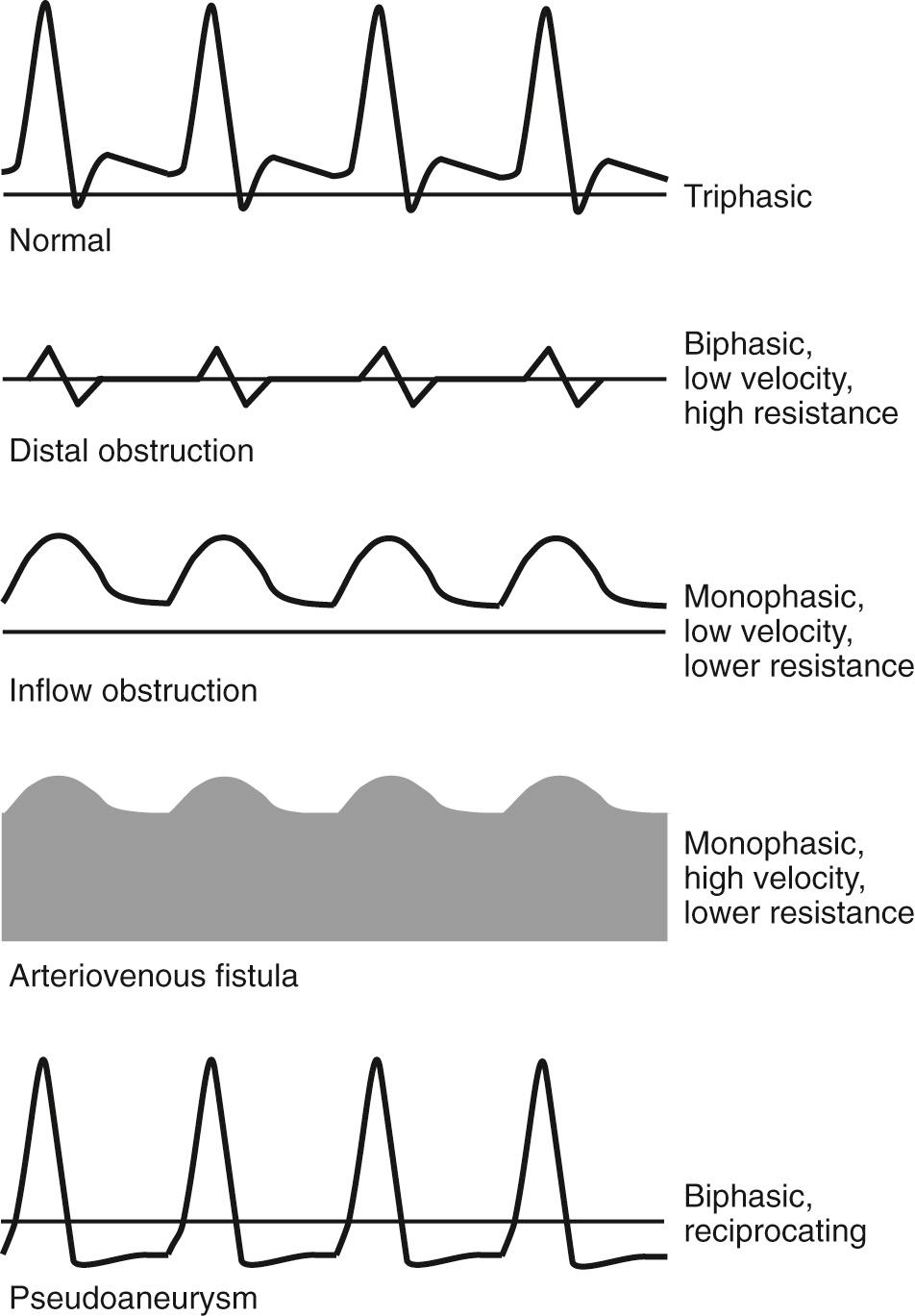
Each lower extremity arterial system is primarily supplied from the common femoral artery, which originates from the external iliac artery at the level of the inguinal ligament and extends caudally a few centimeters until it divides into the superficial femoral artery (SFA) and profunda femoris artery. The profunda femoris artery supplies the femoral head and the deep muscles of the thigh through perforators, as well as the medial circumflex artery and the lateral circumflex artery. The SFA continues along the medial thigh to the adductor canal in parallel with the femoral vein (FV). Below the adductor canal, it becomes the popliteal artery, coursing posterior to the knee and supplying branches of the calf.
The popliteal artery branches into the anterior tibial artery and the tibioperoneal trunk. The anterior tibial artery courses laterally, perforating through the interosseous membrane between the tibia and fibula into the anterior compartment of the lower leg. The anterior tibial artery becomes the dorsalis pedis artery in the dorsum of the ankle and along the first intertarsal space of the foot. The tibioperoneal trunk divides after approximately 3 to 4 cm into the posterior tibial artery and the peroneal artery. The posterior tibial artery courses posterior to the medial malleolus of the ankle. The peroneal artery courses through the interosseous membrane above the ankle, and then supplies branches of the lateral ankle and foot.
Lower extremity arterial inflow from the external iliac artery is assessed by groin insonation in supine position, and then each major vessel in the leg is directly evaluated throughout its entire course. Normal arteries have thin smooth walls with anechoic lumens and lack of atherosclerotic plaques or stenosis on gray-scale imaging ( Fig. 27.2 ). After gray-scale evaluation, long arterial segments can be screened rapidly with color Doppler to find areas of suspected stenosis. Color Doppler is set to barely fill the lumen in a normal area of the artery. Color aliasing can alert the sonographer to areas of luminal narrowing that need to be evaluated further with spectral Doppler to determine significance. For evaluation of focal abnormalities other than stenosis, the examination may be limited to the general region of concern.
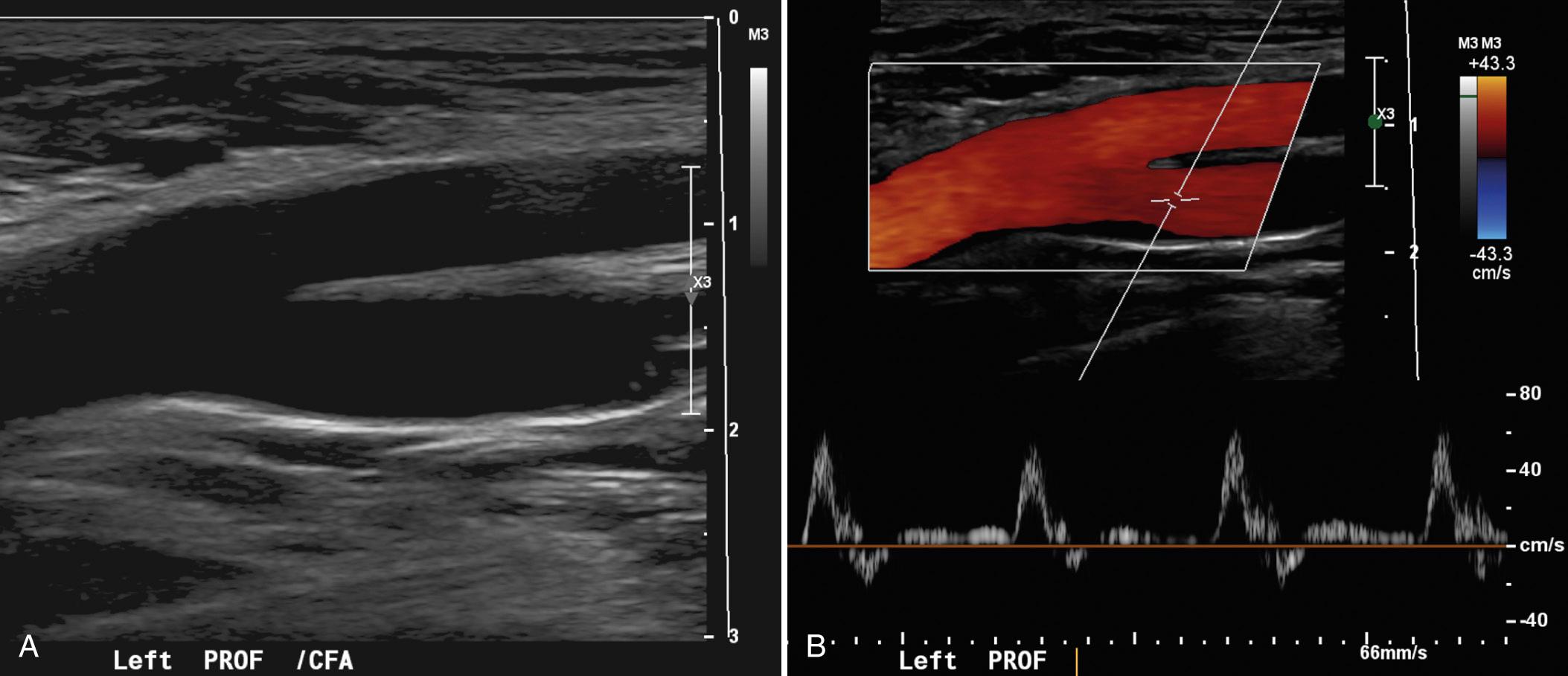
The ACR-AIUM-SRU practice parameter for the performance of peripheral arterial ultrasound suggests that lower extremity ultrasound should examine the common femoral artery; the proximal, mid, and distal SFA; and the popliteal artery above and below the knee. Other arteries are examined as deemed clinically appropriate. The practice parameter states that these may include “iliac, deep femoral, tibioperoneal trunk, anterior tibial, posterior tibial, peroneal, and dorsalis pedis arteries.” The guideline further suggests that angle-corrected longitudinal Doppler and/or gray-scale imaging should be documented in each normal and at any abnormal segment. Angle-corrected spectral Doppler is recommended proximal to, at, and beyond any suspected stenosis. Supine position of the patient is acceptable for the thigh vessels, but a decubitus position may aid evaluation of the popliteal artery. Depending on the symptoms and findings of these arteries, imaging of the iliac arterial system may look for inflow disease, or imaging of the calf arteries may be indicated.
Normal outer diameters of the common femoral artery, SFA, popliteal artery, posterior tibial artery, and anterior tibial artery are 8.1 mm, 6.1 mm, 6.0 mm, 2.1 mm, and 2.0 mm, respectively, and these vessels are slightly larger in males. The common femoral artery, SFA, and popliteal artery become slightly larger with age, whereas the calf arteries become smaller. Laminar flow is present without turbulence or aliasing on color Doppler. A high-resistance triphasic waveform with sharp upstroke and transient flow reversal is typically present in the normal lower extremity arteries on spectral Doppler. A monophasic waveform morphology that does not return to baseline can occur after exercise in normal patients, but can be also seen in lower extremity atherosclerotic disease. For differentiation, the PSV will decrease in the ischemic limb of a patient with peripheral artery disease after exercise, whereas it will increase in a patient with a healthy arterial system.
For calf assessment, a posterior medial approach is used for the posterior tibial artery in the midcalf with longitudinal Doppler, and then the artery can be followed proximally and distally. Alternatively, it can be found at the medial malleolus at the ankle and followed cranially. An anterior transducer placement is applied for the anterior tibial artery with the patient lying supine. The anterior tibial artery is well seen along the interosseous membrane near the fibula. The peroneal artery can also be seen from this anterior probe placement; it is more deeply located posterior to the interosseous membrane. A posterior lateral approach may also be used to locate the peroneal artery.
Acute arterial occlusion is an emergent situation that can generate severe symptomatology and requires immediate attention. It is usually present in the setting of atherosclerotic disease, although traumatic dissection or embolic disease can occur ( Fig. 27.3 , ). Use of Doppler allows for sensitive and specific demonstration of absent flow, and can differentiate occlusion from stenosis in the lower extremity with 98% accuracy. In another study, sensitivities for occlusion of the SFA and popliteal artery were 97% and 83%, respectively. In the lower leg, Doppler performs better in the anterior and posterior tibial arteries than in the peroneal. Doppler sensitivity for patency of the tibial artery was 93% in a recent study, but with many false positives related to angiography.

On gray-scale imaging, the anechoic lumen is typically filled with medium-echogenicity thrombus. Using a similar technique as generally performed for detection of deep venous thrombus, the artery can be externally compressed by the transducer to show focal thrombus that is noncompressible. However, if the artery walls completely coapt, then the findings are likely artifactual. On color and spectral Doppler of an occluded artery, no flow signal should be detectable ( Fig. 27.4 ). Collaterals suggest chronic occlusion, but there may be a superimposed acute-on-chronic thrombotic component ( Fig. 27.5 , ).
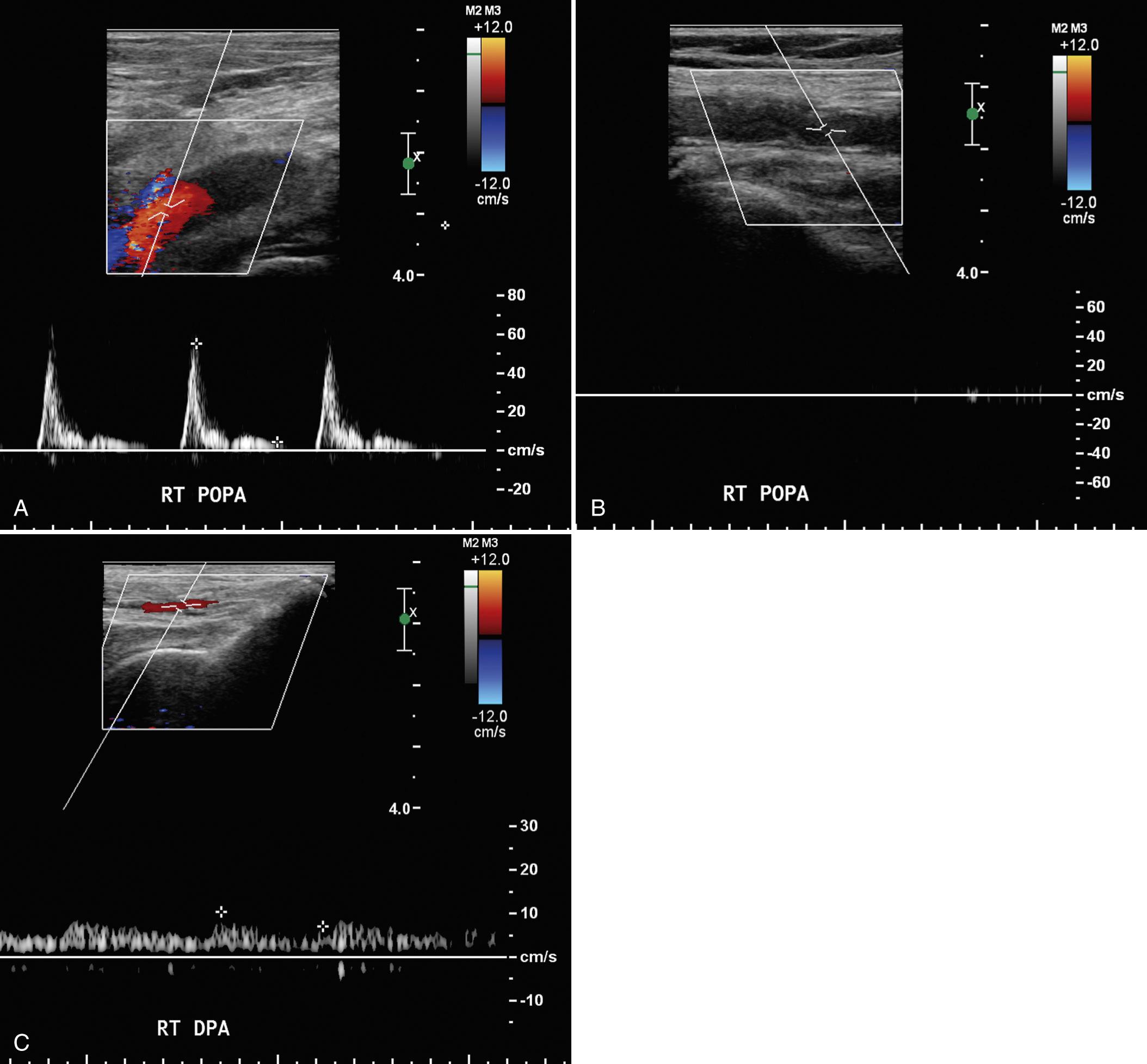
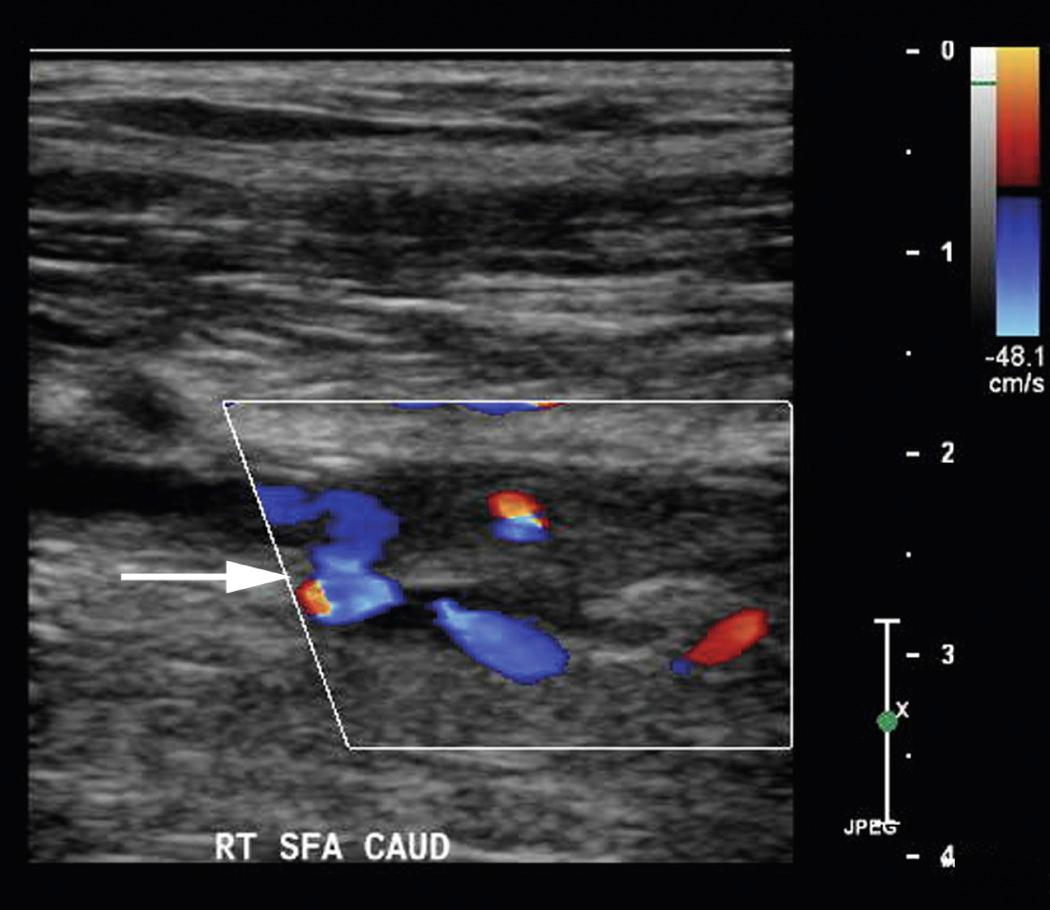
Detection of stenosis in the setting of atherosclerotic disease is important owing to its role as a precursor to occlusion. Ultrasound is the primary screening tool for detection of stenosis, using a combination of gray-scale, color, and spectral Doppler. Duplex Doppler should be performed in these patients because of its superior performance relative to segmental Doppler pressures. In a study of 151 lower extremities, duplex Doppler demonstrated 78% to 95% sensitivity and 97% to 100% specificity for high-grade lower extremity arterial stenosis. Spectral broadening can be seen in nonflow-limiting stenoses less than 50%, with an otherwise normal waveform ( Fig. 27.6 ). As regional measurements are made in the arteries of the lower extremity, there may be a change noted from normal triphasic arterial morphology to a pulsatile but monophasic waveform that does not return to baseline or demonstrate transient reversal ( Fig. 27.7 ). When this transition is encountered, the artery between these two measurements should be more closely evaluated by color and spectral Doppler to locate a focal velocity elevation associated with visible narrowing of the artery. Gray-scale can characterize overall plaque burden, but calcifications may limit sonographic penetration into the artery lumen ( Fig. 27.8 , ).
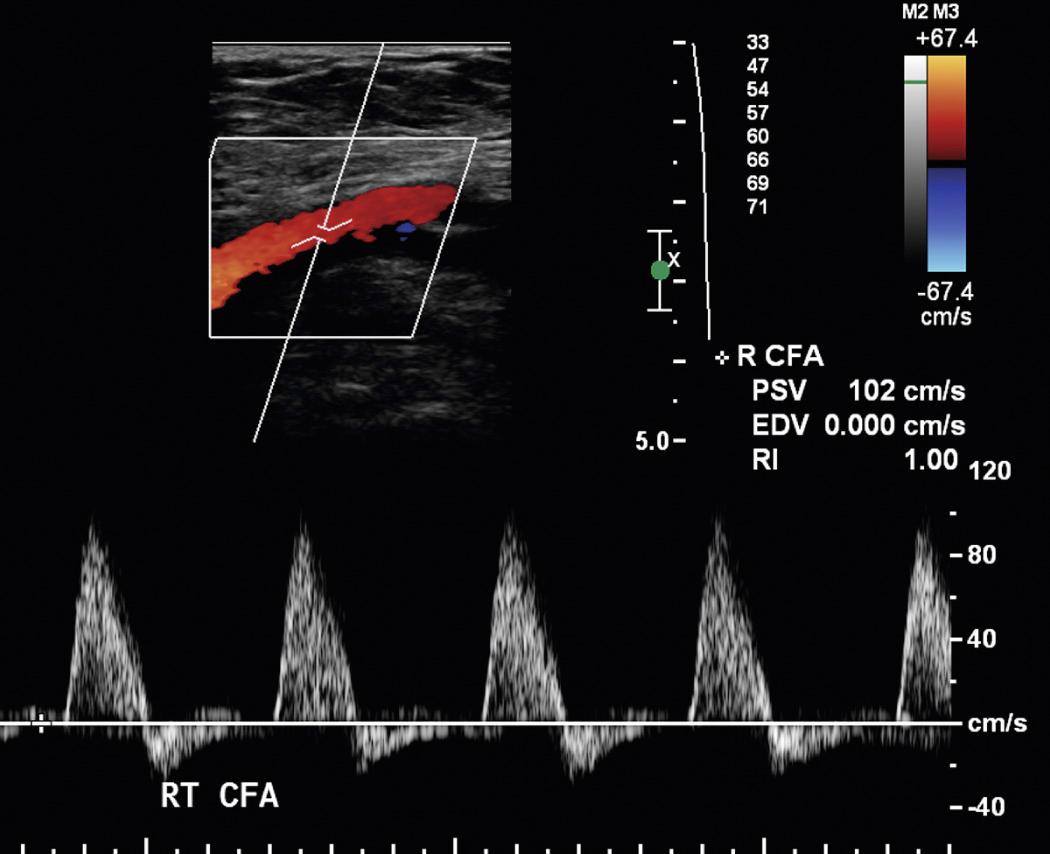
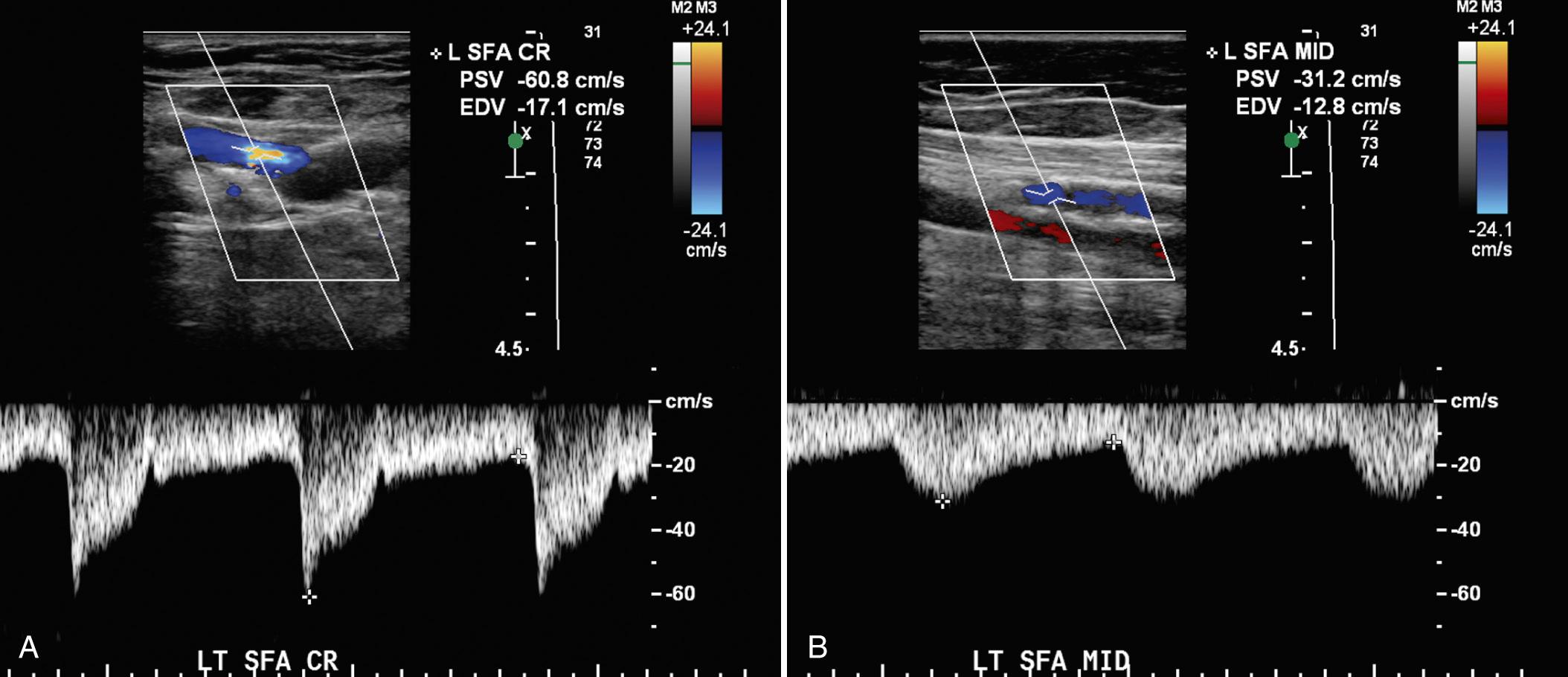
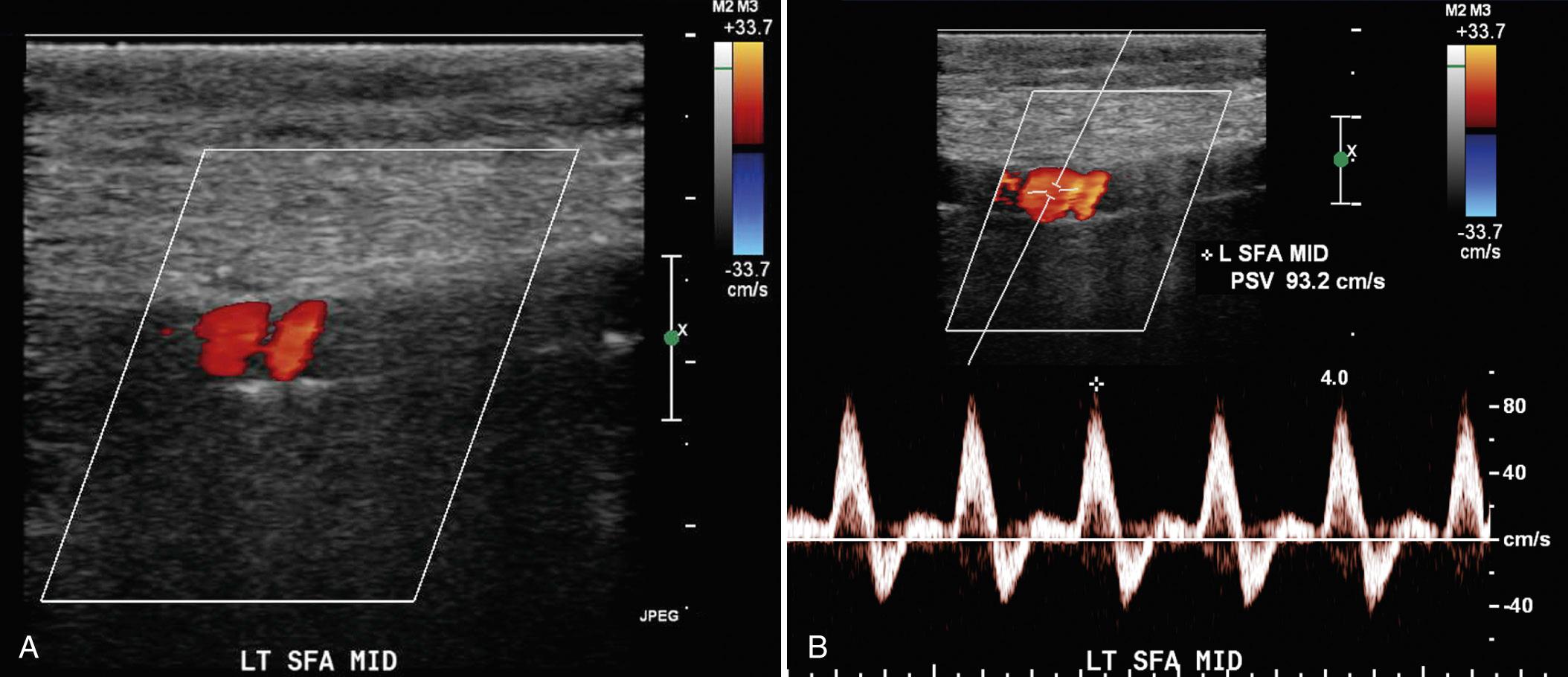
In a patient with diffuse atherosclerotic disease and generalized calcifications, there may be numerous mild stenoses that have a combined effect to reduce flow pressures to the lower leg without a dominant stenosis. Gray-scale imaging is limited in its ability to measure narrowing of the vessel, and velocity and waveform criteria are more widely applied. Color Doppler improves the examination by rapidly depicting areas of turbulent or high-velocity flow that can be further sampled by spectral Doppler for velocity characterization.
The main criteria for characterizing arterial stenosis involve waveform morphology, PSV, and end-diastolic velocity (EDV). For velocity criteria, the absolute values and the peak velocity ratio (defined as peak velocity at or in the downstream jet divided by peak velocity of the artery 2 cm upstream) have both been applied effectively. In a study of 338 arterial segments, focal increase in the PSV ratio at the stenosis relative to the adjacent nonstenotic artery exceeding 2.0 is consistent with at least 50% diameter stenosis when combined with spectral broadening and loss of transient flow reversal in the artery ( Fig. 27.9 ). The distal artery waveform will be abnormal with tardus parvus waveforms in the setting of stenosis greater than 50% ( Fig. 27.10 ) but is typically normal if a lesser degree of stenosis is present. Direct measurement of PSVs can also be performed. For the femoral-popliteal region of native vessels, a combination of thresholds of PSV greater than 200 cm/sec and ratio above 2 : 1 have been suggested as criteria for greater than 70% stenosis with sensitivity of 79% and specificity of 99% ( Fig. 27.11 ).
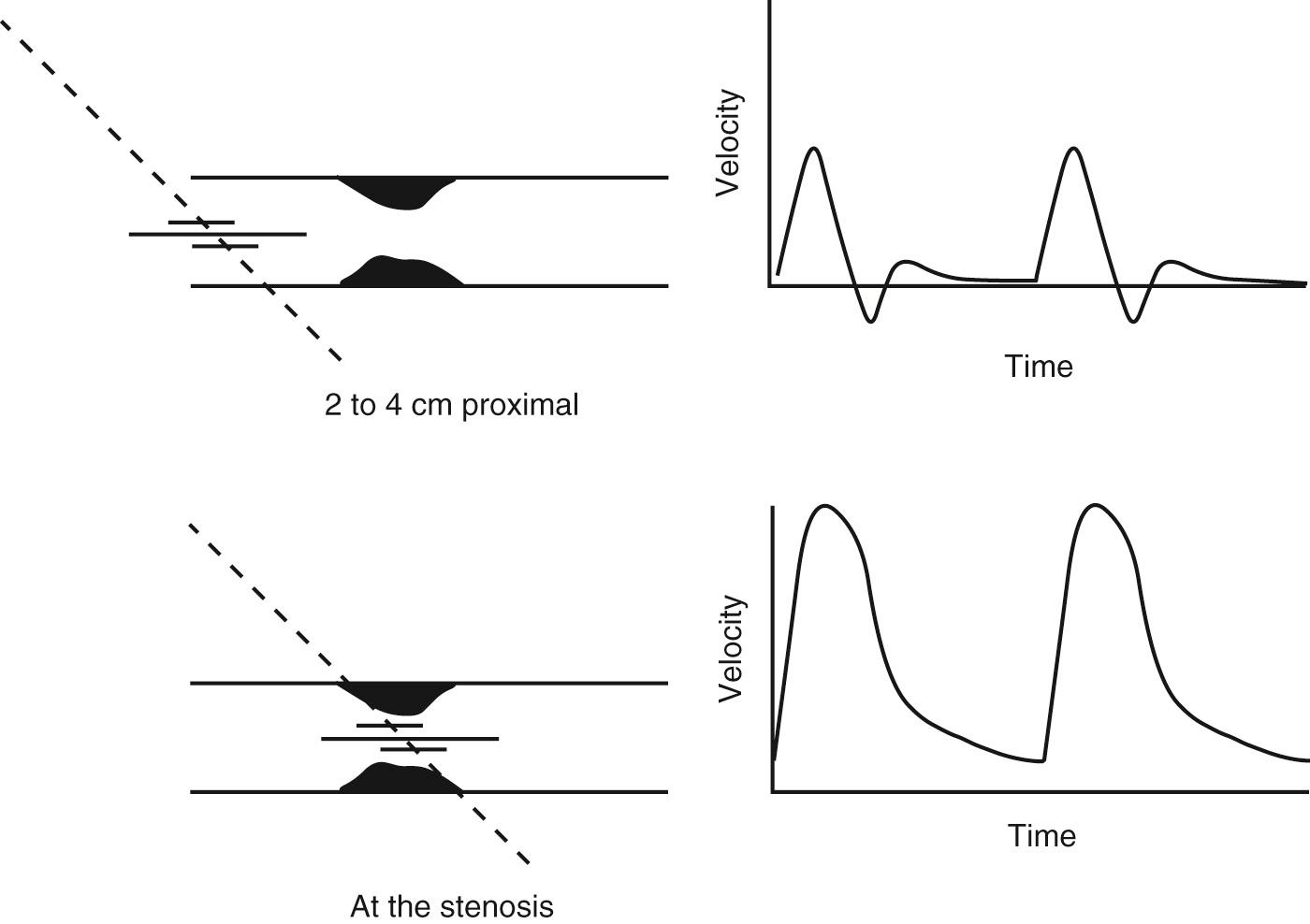
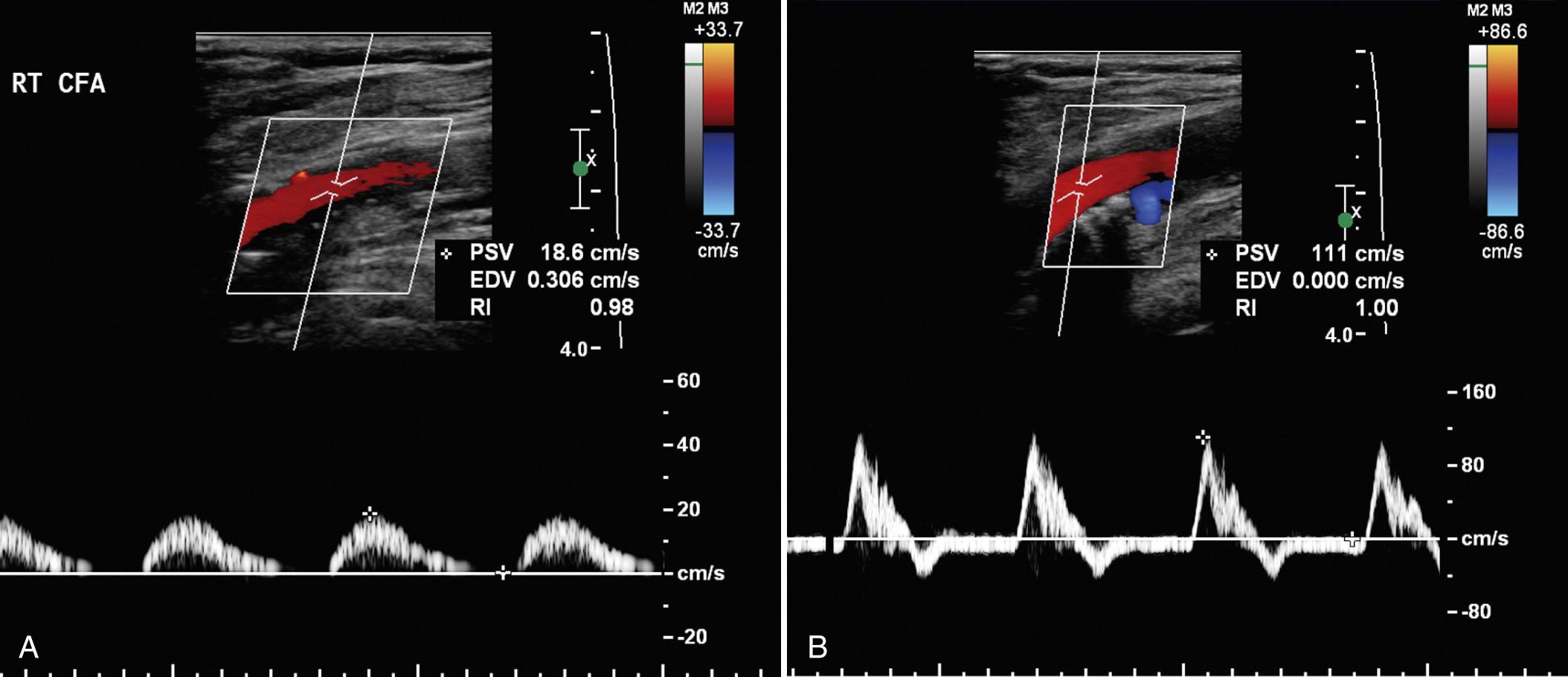
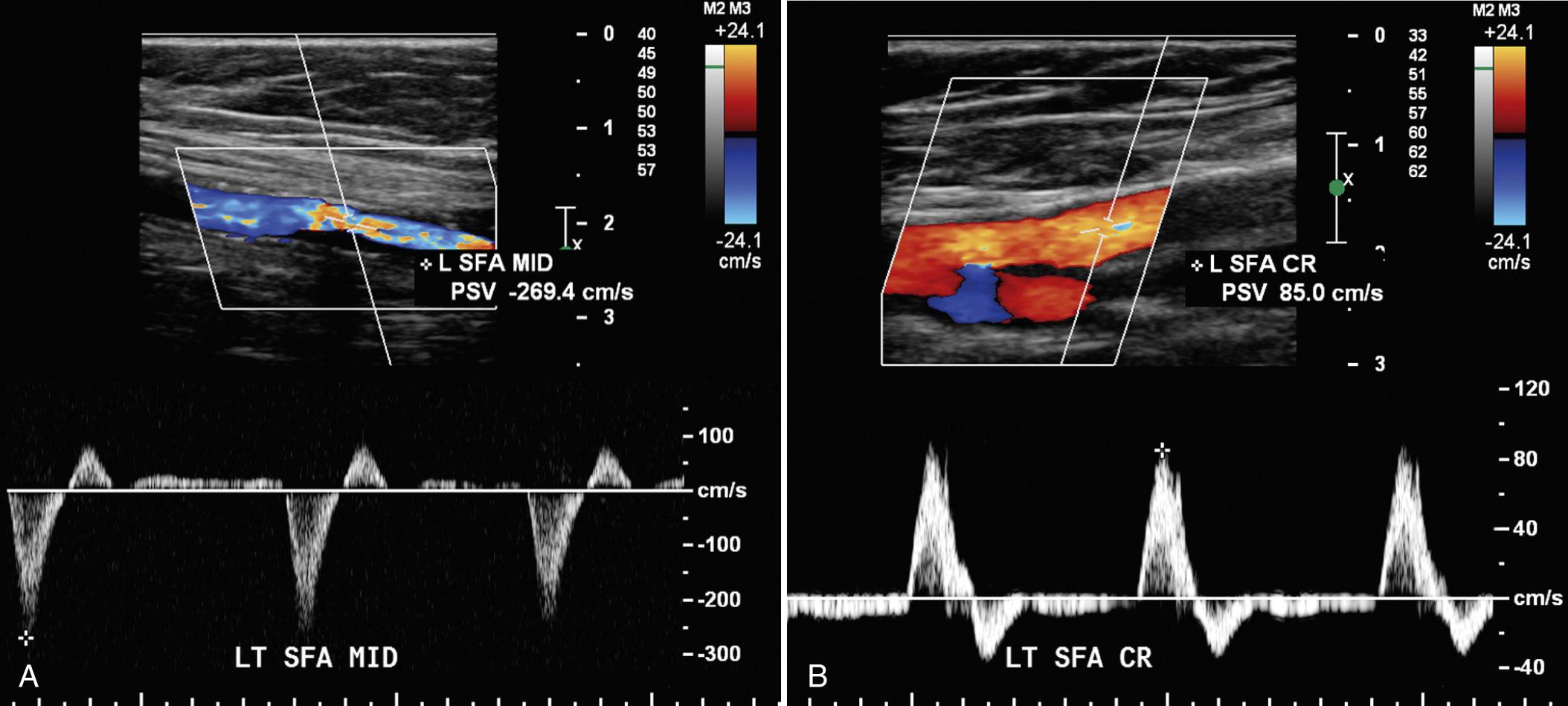
Ultrasound can direct intervention in these patients. Patients with nonacute conditions can benefit from ultrasound to characterize subacute occlusion or embolic disease versus chronic ischemic disease to help the surgeon decide among therapies such as thrombectomy or bypass procedure. Mapping with Doppler before bypass is very useful. Lesions are characterized by severity using the Trans-Atlantic Inter-Society Consensus (TASC) guidelines. Isolated and short category A and B lesions typically are directed to endovascular repair, whereas more complex or longer lesions, C and D, in general require bypass. In one study of 622 TASC C or D lesions, Doppler mapping successfully identified lesions for intervention with sensitivity of 97% and specificity of 99%. Similar high accuracy has been shown in other studies as well.
Doppler can also predict which lesions are suitable for percutaneous transluminal angioplasty with good success. However, duplex assessment may underestimate the length of stenosis. The lesions treated by angioplasty are generally short and isolated and have a diameter reduction of greater than 50%. In patients with endovascular intervention and stenting, Doppler can monitor success of the procedure and survey for recurrent stenosis at follow-up. In patients treated for critical limb ischemia, Doppler follow-up should occur every 3 months for the first year. Normal triphasic waveforms at the ankle help exclude stenosis, but spectral Doppler is still performed even in the absence of symptoms. For evaluation of stenosis within a stented artery, the best Doppler criteria to characterize SFA in-stent stenosis of 80% or greater include a combination of PSV above 275 cm/sec and PSV ratio (the ratio of the highest PSV within the stent to the PSV in a disease-free arterial segment 3 cm above the stented area) above 3.5. In patients with stent repair of SFA stenosis, Doppler and CT angiography have strong agreement.
An aneurysm occurs when weakness of the arterial layers allows expansion of the arterial caliber beyond normal limits. Aneurysms of the peripheral arteries are uncommon, but most are found in the popliteal regions. Less commonly, aneurysms are present in the SFA. In more than half of patients with popliteal artery aneurysm, they are bilateral. An association exists between popliteal artery aneurysms and abdominal aortic aneurysm, and thus if a popliteal artery aneurysm is found, the abdominal aorta should be evaluated. There is also an association among peripheral artery aneurysm, tobacco use, and hypertension. Peripheral artery aneurysms may contain clot, which may result in distal emboli with or without soft tissue ischemia and infarction. In these cases, intervention is necessary regardless of aneurysm size. The walls of an aneurysm may calcify, and the presence of calcifications may have some protective effects against rupture.
On gray-scale ultrasound, an aneurysm may appear as a fusiform anechoic or hypoechoic mass along the course of an artery. The Doppler signal depends on the amount of thrombus, the size of the neck of the aneurysm, and presence of calcification. Aneurysms may be saccular and commonly occur at branch points. The normal popliteal artery measures 4 to 6 mm in diameter. A bulge or focal enlargement of 20% of the vessel diameter constitutes a simple functional definition of an aneurysm ( Fig. 27.12 ). Empirically, a 2-cm cutoff has been used to determine need for intervention. For popliteal artery aneurysm, surgical exclusion (ligation of the aneurysm) is the traditional treatment and has high rates of success. However, a recent meta-analysis showed that endovascular repair has similar success. Doppler ultrasound can be used to monitor the success of the intervention. Aneurysm exclusion with covered stents is an increasingly used therapy in place of surgical intervention. Doppler ultrasound can be used to monitor the patency of the stent and confirm the exclusion of the aneurysm from the circulation.
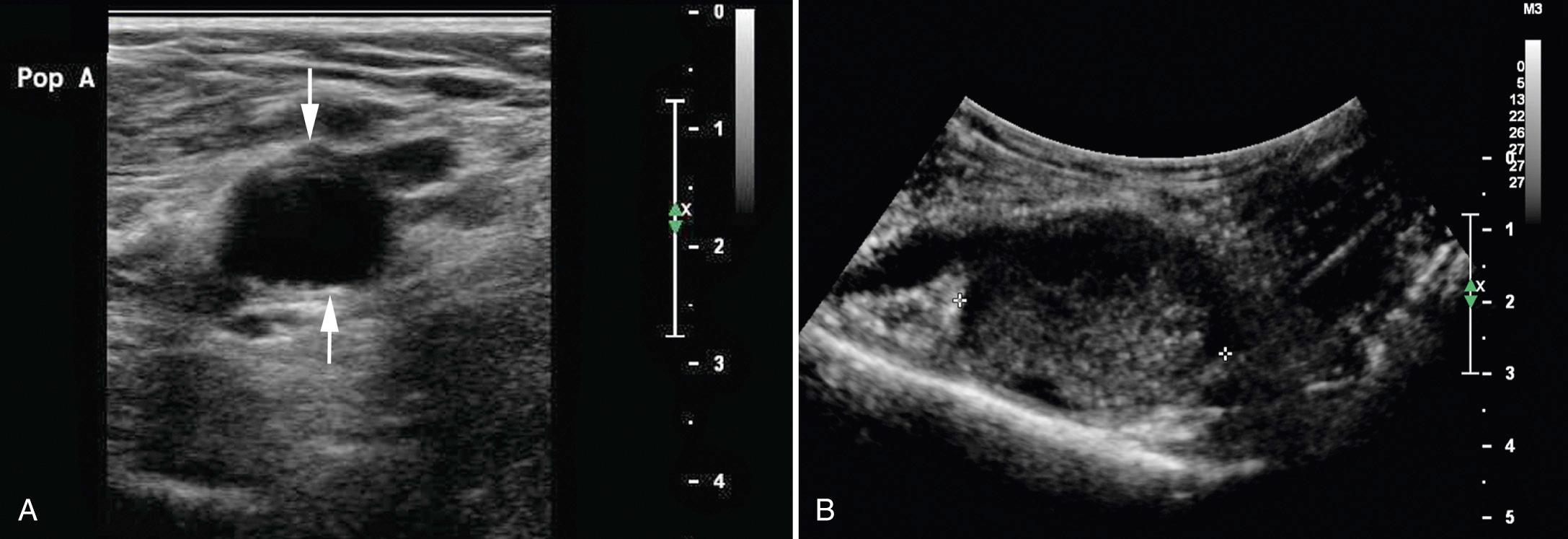
Pseudoaneurysm describes disruption of an artery with flow in a space beyond the vessel wall. It may arise from any arterial structure and may occur with direct trauma or tumor or inflammatory erosion. Pseudoaneurysms are found in less than 1% of diagnostic angiography examinations and more commonly in coronary angiography. Pathologically, the arterial wall has been at least partially breached. Outer arterial layers, perivascular tissues, clot, or reactive fibrosis contain the pseudoaneurysm sac. The mechanism of pseudoaneurysm formation has been well characterized. A hematoma forms adjacent to the artery at the point of injury. Eventual lysis of the clot results in pseudoaneurysm.
A pseudoaneurysm is different from an aneurysm in that at least one layer of wall is disrupted. It differs from active extravasation in that blood within the pseudoaneurysm flows back into the feeding artery through a narrowed opening rather than into adjacent tissues. Arteriovenous communication, when present, is used to guide appropriate therapy. In patients with arteriovenous communication, thrombin repair is contraindicated owing to the potential for embolization of the thrombin into the venous system with resultant unintended regions of thrombosis.
Gray-scale ultrasound is typically performed first to identify the abnormality. The pseudoaneurysm can appear as a round or oval anechoic structure with or without associated thrombus. When present, thrombus appears isoechoic or hypoechoic; it may be located along the edge of the pseudoaneurysm lumen. Attention should be directed to these areas of extraluminal hematoma or any anechoic collections to determine if there are areas of flow with color Doppler. If flow is detected, spectral Doppler is next performed to characterize arterial versus venous flow and to exclude a superimposed AVF. In the patent portion of a pseudoaneurysm, there may be turbulent or disorganized intraaneurysmal flow with a “yin-yang” appearance. Communication of the sac with the adjacent artery occurs through a neck with a typical “to-and-fro” biphasic flow on spectral Doppler ( Fig. 27.13 , ). Measurement of the neck length and diameter of the neck off the artery is performed as part of the assessment before thrombin injection. A neck with larger diameter has clinical implications because these are less successfully treated by thrombin injection. If the sac is thrombosed, the neck may represent the only patent portion of the pseudoaneurysm. At least one-third of pseudoaneurysm require repair, but spontaneous closure is common for pseudoaneurysm smaller than 1.8 cm in diameter. If the sac is patent, ultrasound-guided thrombin injection into the pseudoaneurysm to thrombose is commonly performed, with a success rate of 94% to 97% without surgical intervention. Treatment with sonographically guided direct compression has been used in the past but is less successful (up to 85% pseudoaneurysm thrombosis).
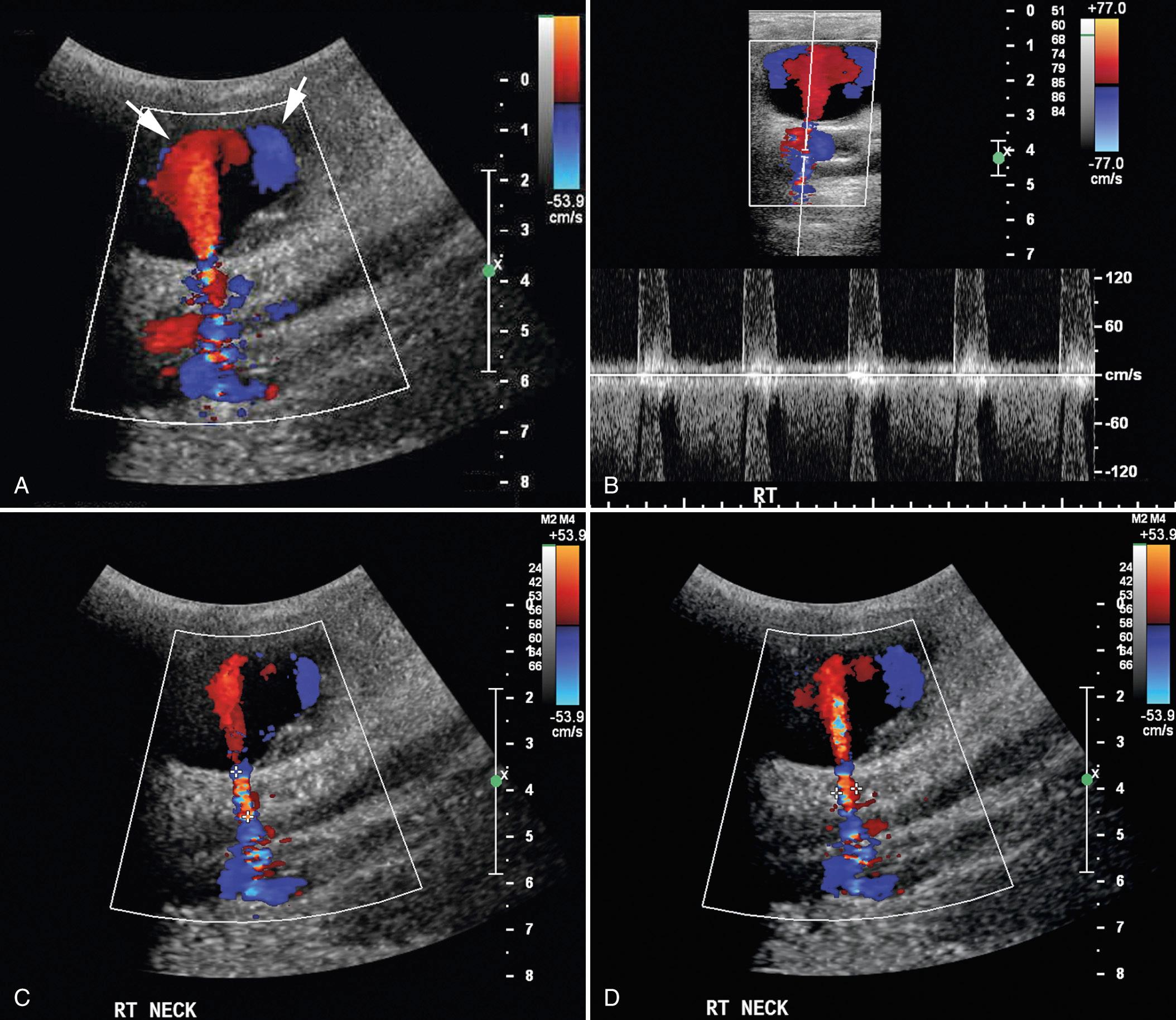
The term “fistula” describes an abnormal communication between the arterial and venous circulations. There is disruption through all layers of the arterial wall as well as a focal disruption of a nearby venous structure, allowing communication from high–arterial pressure to low-pressure veins. This communication bypasses the capillary bed. It can be congenital, acquired, or rarely spontaneous in nature. Fistulas may be seen after autologous vein bypass grafting and do not appear to affect patency of the graft. In the absence of bypass graft, most are acquired and usually associated with a history of trauma. A traumatic arteriovenous fistula may course from normal artery to normal vein in the setting of trauma, but congenital arteriovenous malformations (AVMs) may occur with associated abnormal vascular structures. Many are asymptomatic. However, symptomatic AVFs do not typically spontaneously resolve and often require surgery.
Gray-scale imaging may show very little arterial abnormality in a traumatic fistula, but the cluster of dilated structures of an AVM can be identified. In either abnormality, there may be venous dilation. Color Doppler ultrasound is the best noninvasive imaging modality to evaluate AVF or AVM and may show a large cluster of tortuous vessels with abnormal hyperemic flow. Spectral Doppler waveforms of the inflow arteries feeding the AVF may show low-resistance flow because they bypass the capillary bed. Doppler can show arterialized waveforms in the venous structures near the AVF. Tissue vibration artifact is commonly seen with AVFs, consisting of color pixels erroneously placed in the adjacent soft tissue by the ultrasound scanner because of the marked turbulence of the AVF. If the tissue vibration artifact is seen, a search should be made for an AVF. The arterialized waveform may be better seen during the Valsalva maneuver because with the increased thoracic pressure it causes, normal antegrade venous flow is decreased ( Fig. 27.14 , ).
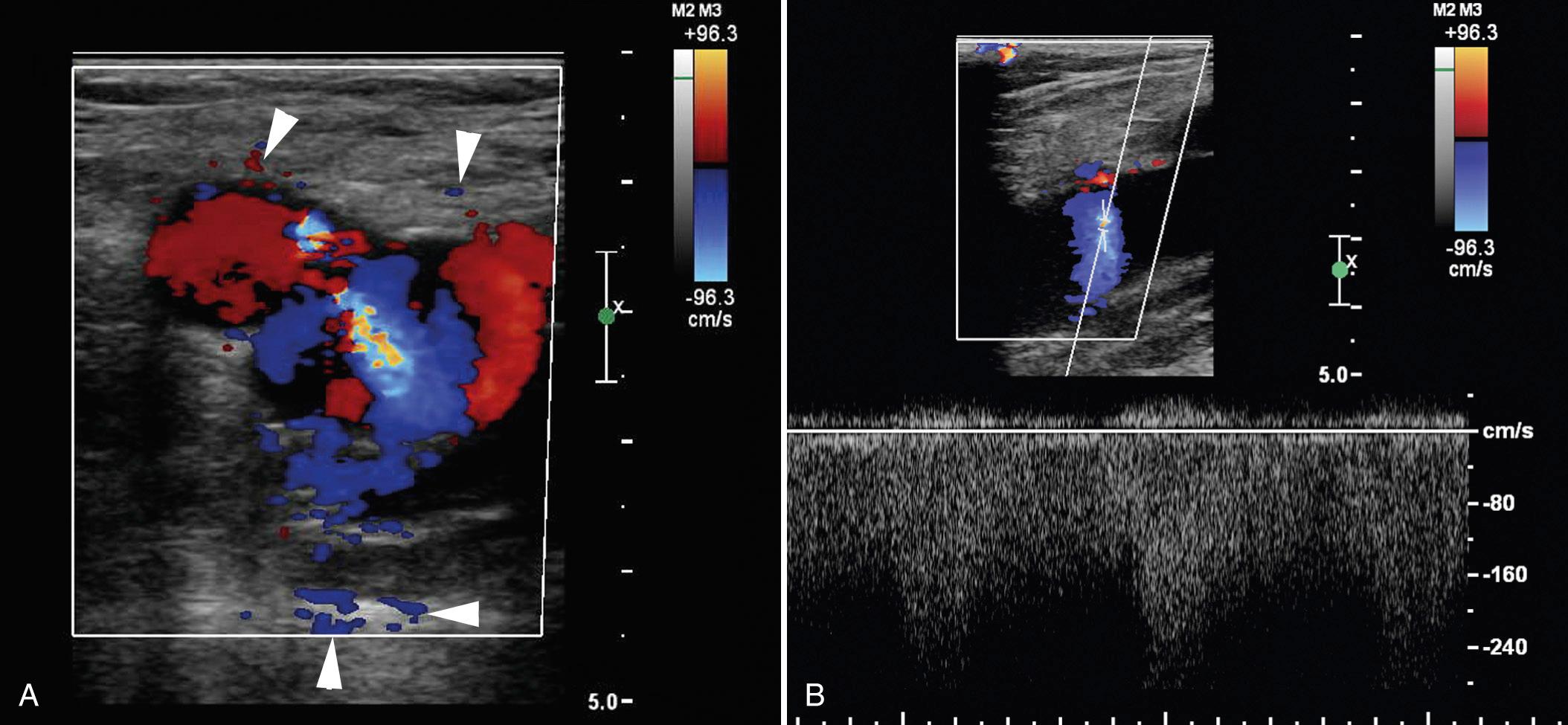
Bypass grafts may use arterial segments or veins for arterial revascularization. Like bypass conduits in other portions of the body, these have potential complications that can limit their functionality. Failures soon after surgery may result from poor bypass conduit selection or surgical technical factors such as poor selection of the sites for anastomosis. In addition, the valves of an autologous vein may not be fully lysed during surgical preparation. Although completion imaging is commonly performed at the time of surgery, a recent study showed no improvement in graft survival in patients with intraoperative completion angiography or ultrasound. In the longer term, fibrosis may occur at the site of a vein valve, or there may be intimal hyperplasia at an anastomotic region. If the bypass survives long enough, the underlying atherosclerotic disease may affect the bypass and inflow vessels to limit function. For synthetic grafts, the characterization of occlusion is similar to the native vessels, with absence of flow on color or spectral Doppler. Echogenic thrombus may be identified within the graft on gray-scale technique.
Ultrasound is a good technique to identify lesions that are likely to result in native vein bypass graft failure. Once the arterial bypass graft has been created, ultrasound is the primary screening modality; Doppler surveillance with revisions when needed is cost-effective. The diagnosis depends on visible identification of stenosis on gray-scale imaging in combination with characterization by color and spectral Doppler. Normal triphasic or biphasic waveforms in the ankle arteries distal to the bypass suggest patency of the bypass. Generalized reduced or monophasic flow velocities in a graft are concerning for disease, and further search for a focal abnormality should be performed. Color Doppler sonography can be used to search for areas of aliasing, and subsequent spectral Doppler evaluation for velocity changes is then performed. When a stenosis is detected in a nonbranching vessel, a velocity ratio can be applied to evaluate significance. The PSV ratio is calculated by dividing the PSV at the stenotic site by peak velocity in the graft 2 cm upstream. A PSV ratio of at least 2.0 corresponds to at least 50% diameter stenosis. Likewise, a PSV above 180 cm/sec has been associated with stenosis of greater than 50% diameter in lower extremity bypass vein grafts ( Fig. 27.15 , ).
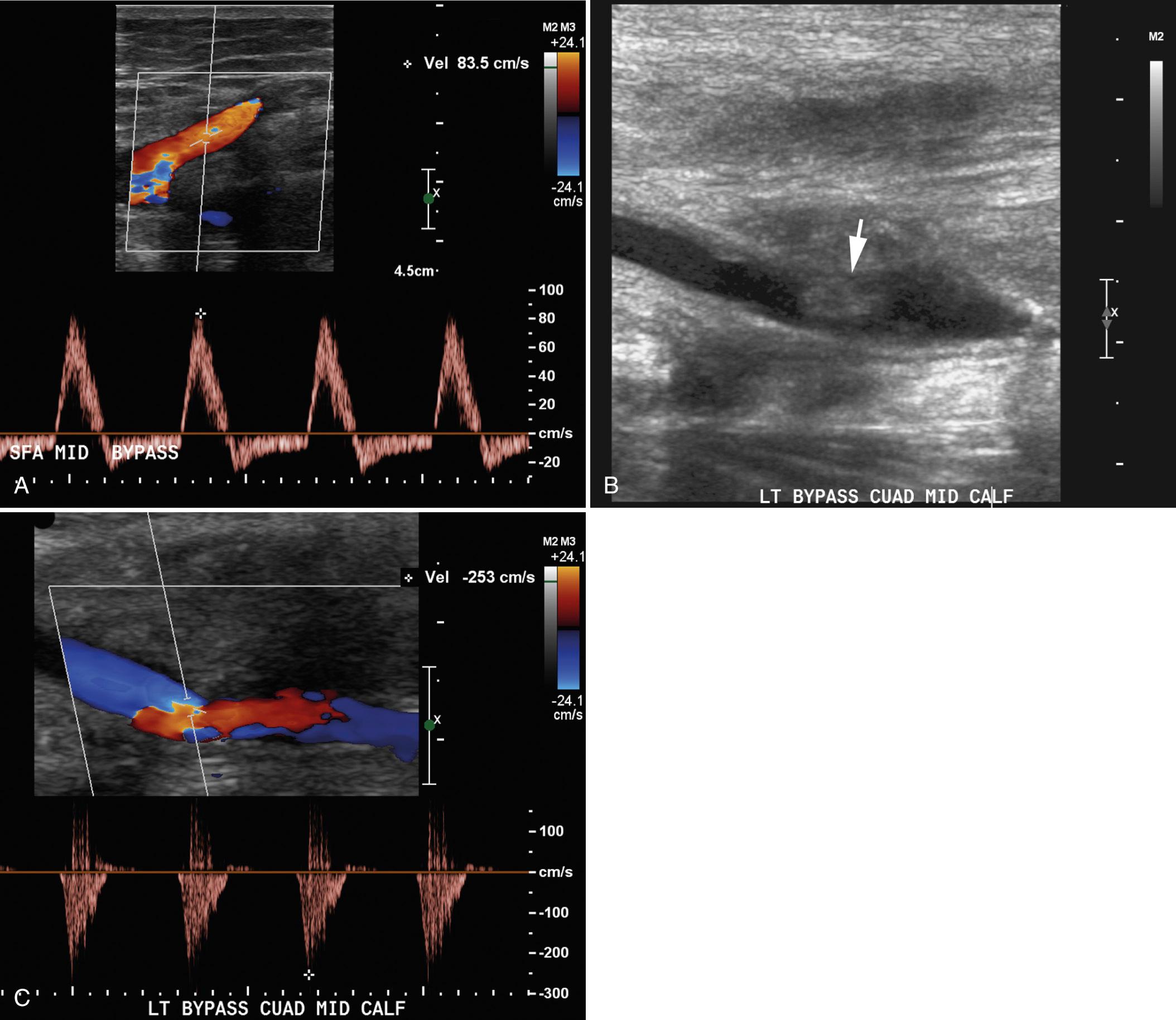
Several ultrasound parameters, including PSV ratio, are associated with future bypass graft dysfunction. Once the PSV ratio measures at least 3.5 to 4.0, showing severe stenosis, treatment should be considered if it has not been performed at less severe degrees of stenosis, even in less symptomatic patients. A recent study of Doppler and CT showed that patients with PSV ratio above 3.5 were at high risk for graft failure, whereas high-grade stenosis on CT did not correlate as well with graft failure. Velocity criteria for severe stenosis used by Wixon and colleagues suggest that PSV above 300 cm/sec and PSV ratio above 3.5 should direct the patient to intervention of a vein graft stenosis. In patients who meet these criteria, the intervention should be immediate if flow velocity within the graft falls below 45 cm/sec. Decreased flow relative to a prior study is also a worrisome finding on spectral Doppler. In surveillance of vein grafts by Doppler with intervention on stenotic lesions, there is increased survival of the surveillance group. In patients with greater than 70% stenosis, 100% of grafts failed without revision, but only 10% failed with ultrasound detection and a subsequent revision pathway.
Patients with venous bypass graft may form pseudoaneurysms or true aneurysms, but these are rare. When present, they occur most frequently in the anastomotic regions. In a study of saphenous vein grafts, only 10 of 260 (4%) developed true arterial aneurysm, with higher incidence in patients with preexisting aneurysm and in males. The average time to diagnosis was 7 years after graft placement.
Each upper extremity arterial system is supplied from either the brachiocephalic artery (right) or the subclavian artery (left) in patients without normal anatomic variations. The artery is anterior to the vein when insonated from the supraclavicular fossa. The subclavian artery courses laterally and becomes the axillary artery once it is beyond the lateral margin of the first rib. The axillary artery courses medially over the proximal humeral head to the inferior margin of the pectoralis muscle, where it becomes the brachial artery. The brachial artery typically courses along the medial upper arm to the antecubital fossa and divides into the radial, ulnar, and smaller interosseous arteries.
Occasionally, there is high brachial artery bifurcation above the antecubital fossa ( Fig. 27.16 ). Regardless of the level of origin, the radial and ulnar branches extend to the wrist. On gray-scale imaging, normal upper extremity arteries have smooth walls with anechoic lumens and lack of atherosclerotic plaques or stenosis, similar to lower extremity arteries. Laminar flow is present without turbulence or aliasing on color Doppler. A similar high-resistance triphasic waveform with sharp upstroke and transient flow reversal is typically present in the upper extremity arteries on spectral Doppler.
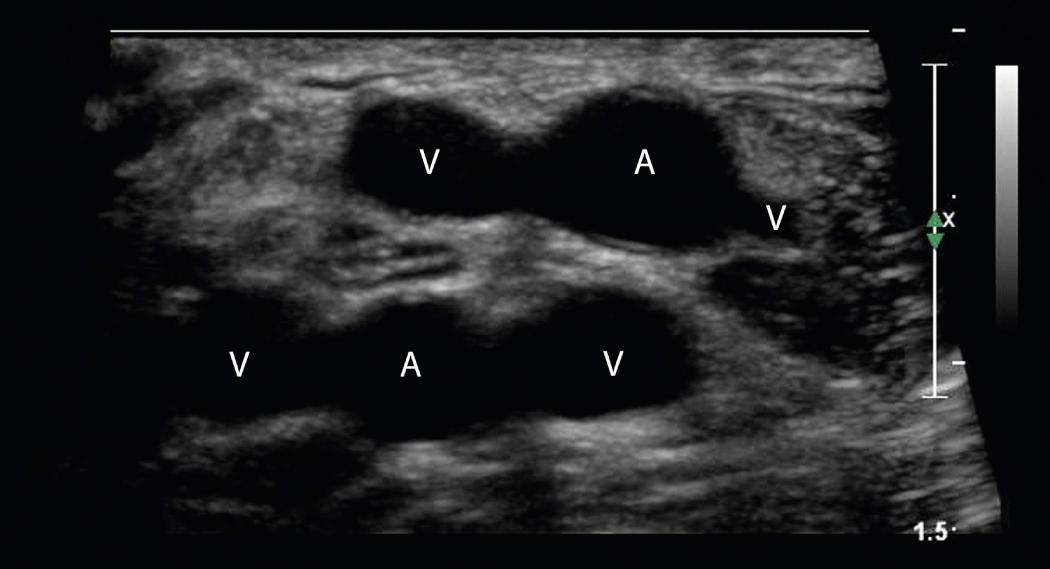
Higher frequency imaging is usually possible owing to decreased size of the arm with respect to the leg. The subclavian artery, axillary artery, and brachial artery are evaluated to the level of the elbow. Both upper extremities should usually be insonated so that the symptomatic side can be compared with the asymptomatic. The ipsilateral innominate artery should be evaluated to determine an abnormal inflow etiology of the problem when the subclavian artery waveform is abnormal. In the forearm, imaging of the radial and ulnar arteries is the key to most diagnoses.
The ACR-AIUM-SRU practice parameter for the performance of peripheral arterial ultrasound suggests that upper extremity ultrasound should examine the subclavian artery, axillary artery, and brachial artery. Other arteries are examined as deemed clinically appropriate. It states that these may include “innominate, radial, and ulnar arteries, and the palmar arch.” The guideline further suggests that angle-corrected longitudinal Doppler and/or gray-scale imaging should be documented in each normal and at any abnormal segment. Angle-corrected spectral Doppler is recommended proximal to, at, and beyond any suspected stenosis.
Upper arm arterial occlusion is usually the result of trauma, often iatrogenic. The rate of radial artery occlusion after artery access for coronary angiography may be as high as 30.5%, although lower rates are also reported in the literature. For surgical bypass harvest planning, documentation of patency of the palmar arch is an additional component. For detection and characterization of arterial aneurysm, the maximal outer diameters of the aneurysm should be measured in transverse (short axis) with gray-scale technique. Doppler can differentiate the patent component from mural thrombus. In pseudoaneurysm characterization, the size and Doppler components are also measured, but the pseudoaneurysm neck is also evaluated with spectral Doppler as detailed earlier in the section on lower extremity arteries ( Fig. 27.17 , and ). If there is concern for AVF, both the arterial inflow portion and venous outflow should be characterized by duplex Doppler within several centimeters of the pseudoaneurysm, because the characteristic arterialization of the downstream venous waveform may be dampened farther away from the fistula. Turbulent flow through the fistula may affect surrounding tissues causing a tissue reverberation artifact, which may be the first clue that an AVF is present.
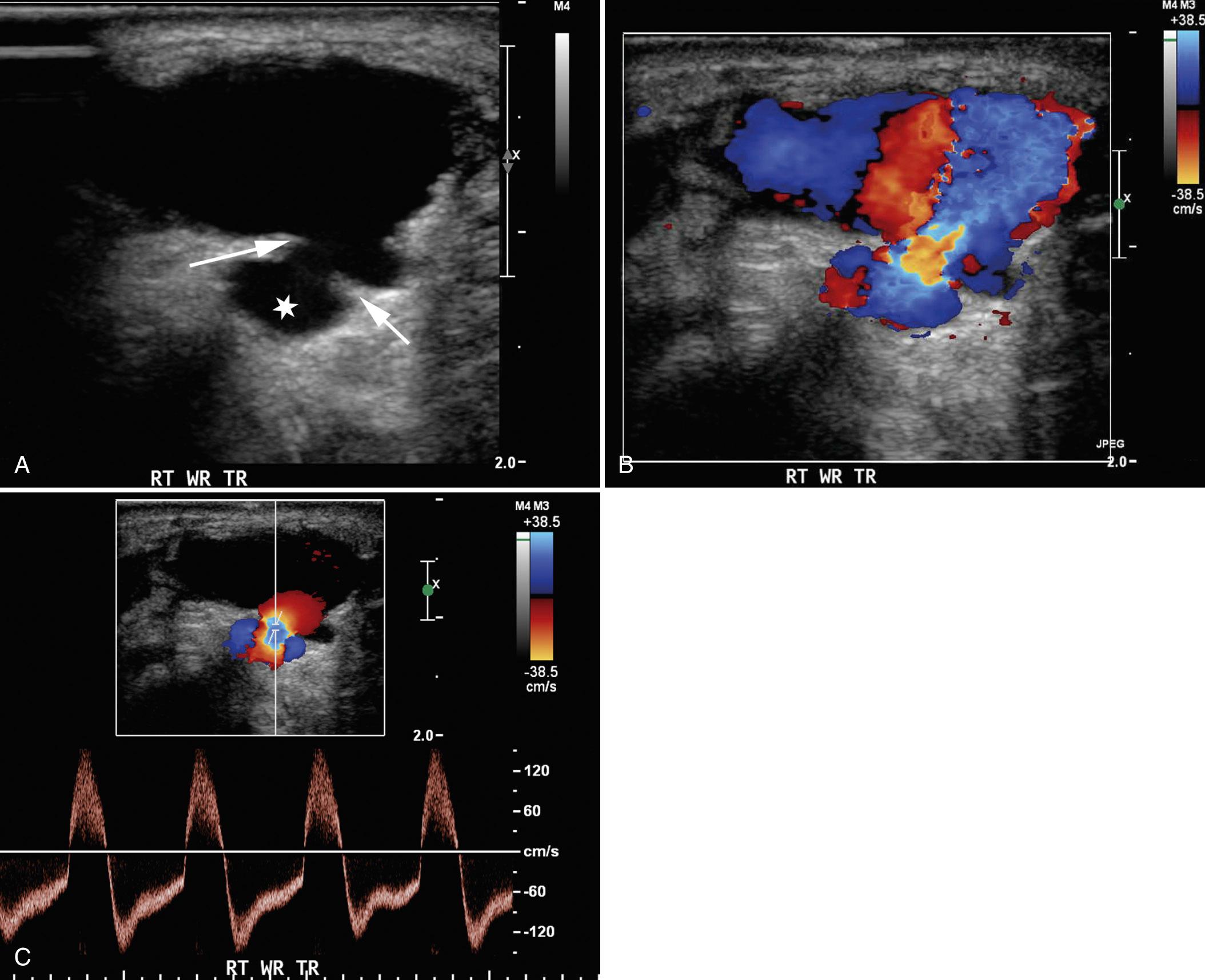
Atherosclerotic disease can cause upper extremity stenosis but is a less common problem in the arm than encountered in the lower extremities. Gray-scale findings are similar to the lower extremities and include intimal plaques and/or visible irregularity of the vessel lumen. Color Doppler may show aliasing with turbulent flow similar to those findings seen in lower extremity arterial stenosis. On spectral Doppler, velocity criteria are not well defined for the upper extremity arteries. However, for a stenosis in most nonbranching arteries, a greater than 2 : 1 PSV ratio of the stenosis relative to the upstream artery within 2 to 4 cm is consistent with at least 50% diameter stenosis. Depending on the timing and whether collaterals have formed, this degree of stenosis may or may not be symptomatic or clinically significant ( Fig. 27.18 ).
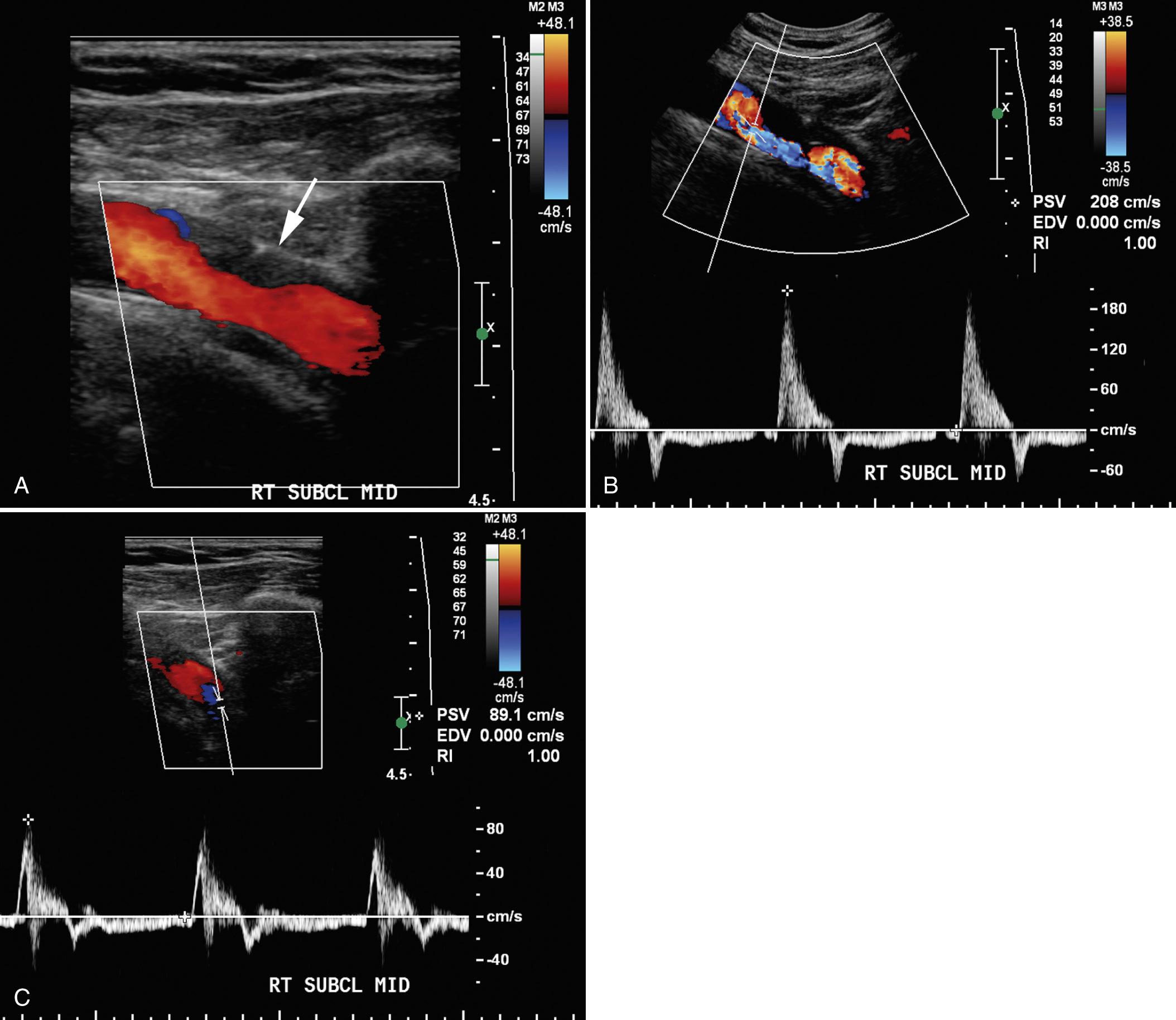
Subclavian stenosis most commonly occurs proximal to the origin of the left vertebral artery. In a subset of patients, flow to the arm is provided by filling through the vertebral artery via retrograde flow. If this reversed flow is significant, there can be a steal phenomenon (“subclavian steal”) from the brain, leading to dizziness with certain arm movements as additional flow is diverted to the arm. In these patients, the vertebral artery waveform should be insonated ( Fig. 27.19 , ). Transient early systolic deceleration with resultant transient cessation of antegrade flow or transient reversal of flow ( Fig. 27.20 ) correlated with subclavian artery mean diameter stenosis of 72% and 78%, respectively. Similar stenosis can occur in the right subclavian artery, but less frequently. If these abnormal vertebral artery waveforms are seen, an attempt should be made to directly visualize a stenosis by gray-scale and duplex Doppler in the subclavian artery itself.

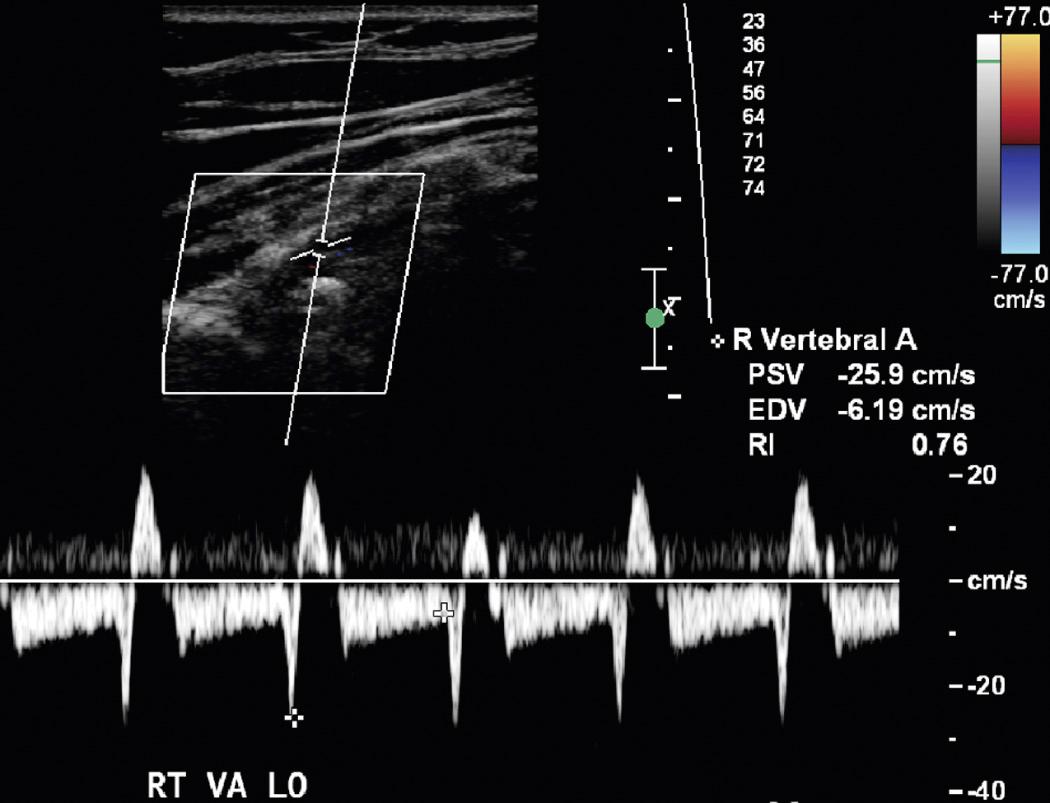
In distal upper extremity ischemic symptoms, embolic or traumatic injury (commonly iatrogenic) to the artery should also be considered. If embolic phenomena are seen, evaluation for thoracic outlet syndrome should be considered. In patients with symptoms elicited by specific positioning of the arm, thoracic outlet syndrome is a form of arterial stenosis that should be considered. It occurs by external compression of the artery by adjacent muscles during abduction of the arm, and this narrowing can affect the waveform morphology of the downstream arteries. Bone and rib anomalies frequently contribute to the pathology. The velocities in the artery should be evaluated during adduction or neutral position then compared with velocities and waveforms in abduction. Over time, the artery may become injured, and this can lead to occlusion and formation of emboli, which may also be visible sonographically. These emboli can then migrate distally within the upper extremity to cause pain in regions such as the hand. For sonographic evaluation of thoracic outlet syndrome in the proper clinical presentation, it is important to begin by insonating the arteries with the arm in neutral position for baseline waveform characterization. Waveforms are acquired from the forearm arteries with the patient sitting comfortably in an upright, seated position. Once the baseline morphology is clearly defined, the arm is moved into the inciting position, usually with abduction and elevation of the arm with external rotation. A combination of inspiration, breath holding, neck extension, and neck turn to the affected side, known as the Adson maneuver, may elicit a positive finding on Doppler. The waveform is monitored as the arm is moved into a variety of positions to elicit symptoms. If abnormal waveforms are not readily apparent, a variety of positions should be tested ( Fig. 27.21 ). If positive, a diminished waveform should be apparent in the arteries of the forearm. Once this has been identified, it may be helpful to repeat the baseline and positive results to show reproducibility of the findings. Further support of the diagnosis includes visible narrowing identified in the subclavian artery, or the presence of an aneurysm in this region, if found. Pseudoaneurysms are frequently present in the setting of thoracic outlet syndrome and can lead to embolic events. Care must be taken in the diagnosis because hyperextension can produce arterial flow abnormality in up to 20% of normal volunteers.
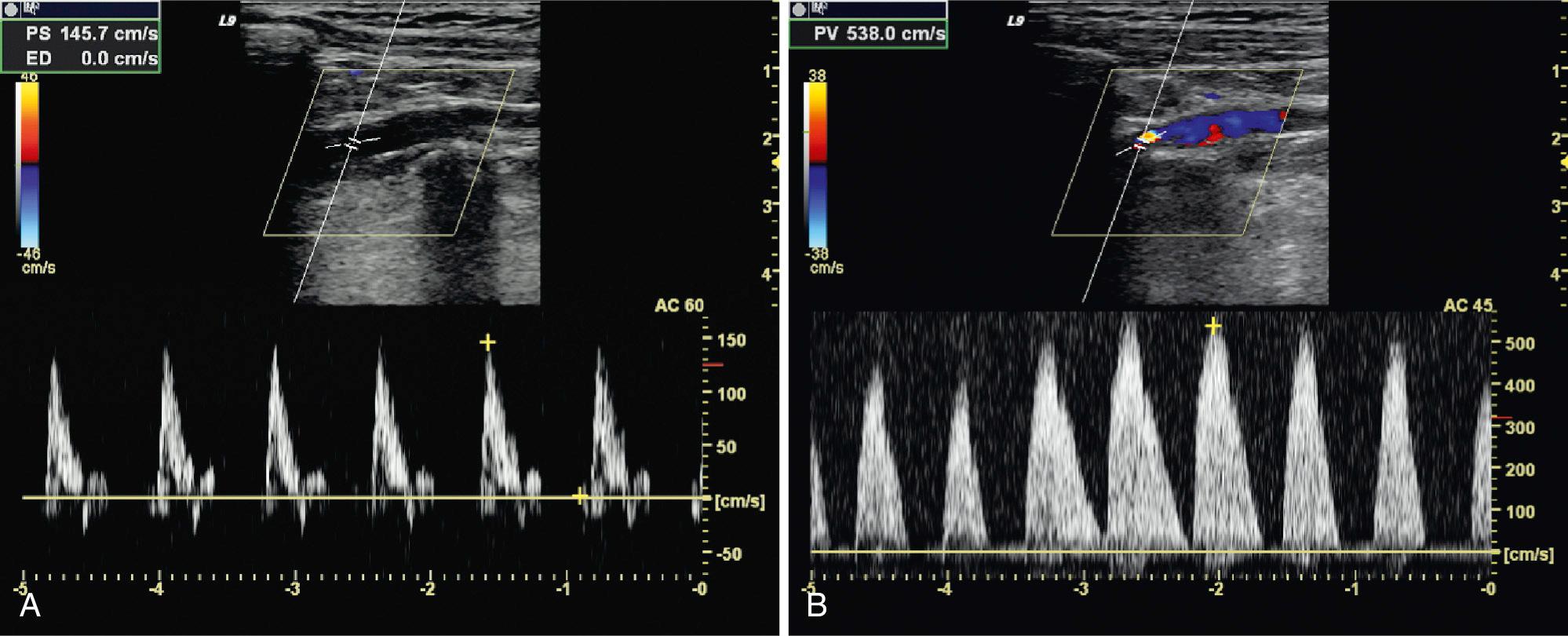
Another use of Doppler in bypass patients is to determine suitability of the radial artery for coronary artery grafting. The ulnar artery typically provides the dominant source of blood flow to the hand. The ulnar artery supplies the superficial palmar arch, which is often incomplete. The radial artery supplies the deep palmar arch, which is more commonly complete, in communication with the ulnar artery. If the superficial palmar arch in the hand is patent, thus allowing flow to the entire hand through the ulnar artery, then the radial artery is harvested. Thus evaluation of palmar arch patency is necessary before harvest. Doppler evaluation of patency is more accurate than the modified Allen test on physical examination, because only about 5 of 43 (12%) patients with an abnormal modified Allen test result will have abnormal Doppler findings.
A small linear array 12- to 15-MHz “hockey stick” transducer initially is used to determine antegrade flow of the ulnar artery and radial artery at the wrist. With duplex Doppler, arterial flow to the hand in the superficial palmar arch at the thenar eminence near the crease of the base of the thumb is characterized first with normal distal radial artery inflow. Subsequently, the radial artery is transiently occluded by direct compression of the radial artery at the wrist, and the resultant spectral Doppler waveform is evaluated. Care should be taken during examination not to hyperextend the hand with regard to the wrist, because a false-negative examination finding may incorrectly suggest lack of patency of the arch. In patients with a patent superficial palmar arch, there should be reversed flow of the radial artery in the hand, measured at the thenar eminence or in the region of the snuff box between the first metacarpal and second carpal bone. If there is no flow or absent reversed flow, then the radial artery of that upper extremity is not suitable for harvest owing to an incomplete arch ( Fig. 27.22 ). Increased flow in the ulnar artery may also occur during radial artery compression if the arch is patent.
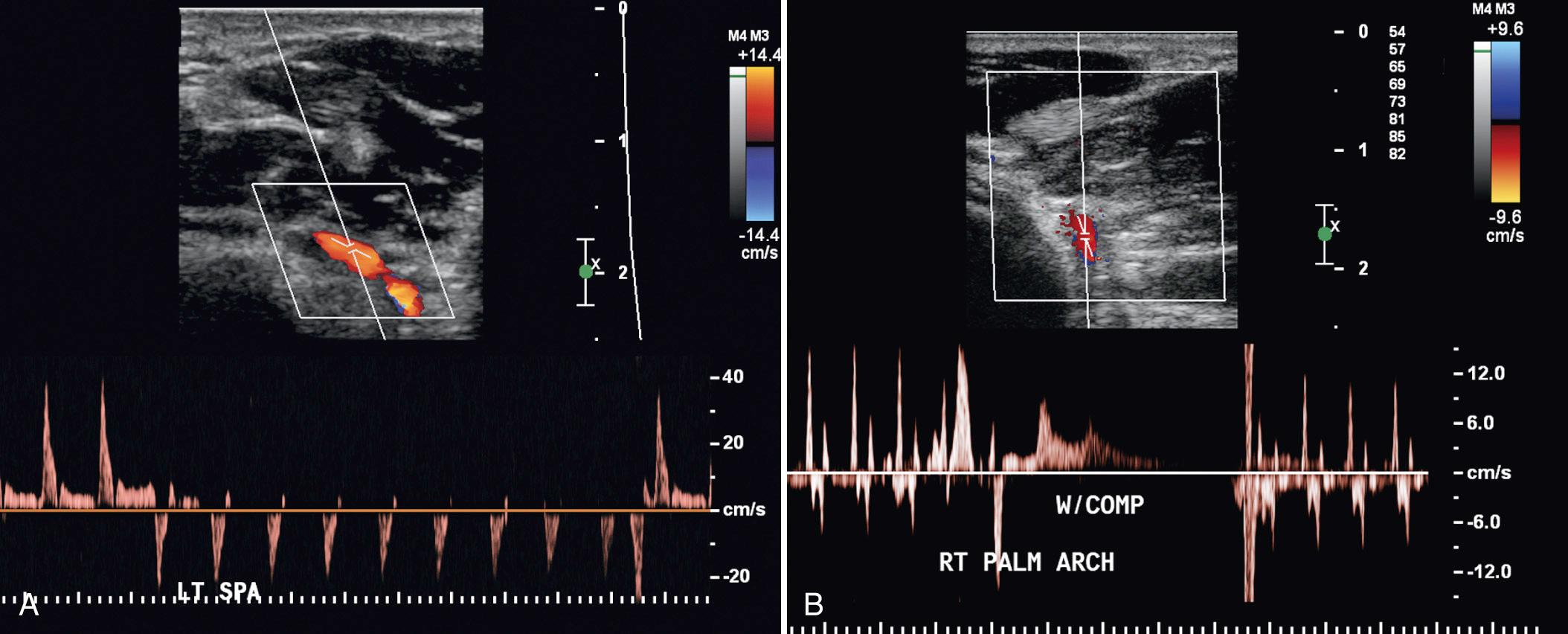
Become a Clinical Tree membership for Full access and enjoy Unlimited articles
If you are a member. Log in here